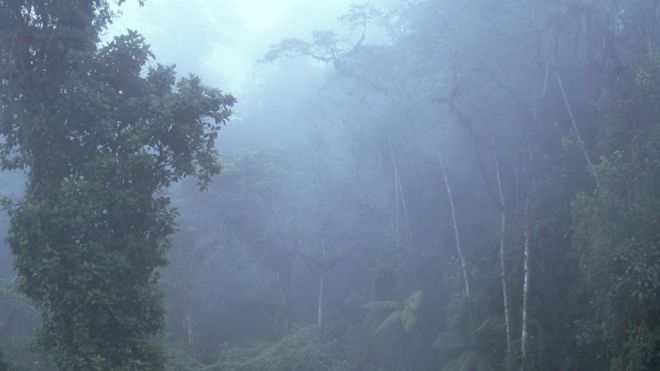Welcome to DU!
The truly grassroots left-of-center political community where regular people, not algorithms, drive the discussions and set the standards.
Join the community:
Create a free account
Support DU (and get rid of ads!):
Become a Star Member
Latest Breaking News
General Discussion
The DU Lounge
All Forums
Issue Forums
Culture Forums
Alliance Forums
Region Forums
Support Forums
Help & Search
Latin America
Related: About this forumLost society hidden in Ecuador's 'pristine' cloud forest

MORLEY READ
Lost society hidden in Ecuador’s ‘pristine’ cloud forest
By Victoria Davis Jul. 17, 2018 , 3:30 PM
Tiny pieces of pollen and charcoal found in lake sediment in Ecuador’s Quijos Valley have revealed a detailed timeline of what happened to an indigenous people forgotten from history, National Geographic reports. Thousands of individuals made up the Quijo groups, which lived across the region in agrarian communities until the Spanish arrived in 1540s. Large nuggets of charcoal found in the silt marked the height of the conflict, and pollen spots showed the fast changing growth of plant life after the Quijos were eradicated from the area by 1578, scientists report in Nature Ecology & Evolution. The cultivated valley was quickly overtaken by forest, which grew undisturbed by humans for the next 130 years, eventually to be mistaken by botanists in the 1850s as part of the untouched cloud forest.
http://www.sciencemag.org/news/2018/07/lost-society-hidden-ecuador-s-pristine-cloud-forest
~ ~ ~

Ecuador's scenic cloud forests hide evidence for the agricultural communities that once thrived in the region.
PHOTOGRAPH BY JOEL SARTORE, NATIONAL GEOGRAPHIC
SCIENCE & INNOVATION
Traces of Lost Society Found in 'Pristine' Cloud Forest
Deep in Ecuador’s lush Quijos Valley, a society thrived—and then disappeared. But a lake preserved its story.
BY ALEJANDRA BORUNDA
PUBLISHED JULY 16, 2018
In the 1850s, a team of botanists venturing into the cloud forest in the Quijos Valley of eastern Ecuador hacked their way through vegetation so thick they could barely make their way forward. This, they thought, was the heart of the pristine forest, a place where people had never gone.
But they were very wrong. Indigenous Quijo groups had developed sophisticated agricultural settlements across the region, settlements that had been decimated with the arrival of Spanish explorers in the 1500s. In their absence, the forest sprung back. This process of societal collapse and forest reclamation is described in a new study published today in Nature Ecology and Evolution.
Linking Amazon and Andes
The Quijos Valley lies in one of the most biodiverse cloud forests in the world, along a pre-Columbian trade route that linked the rich Amazonian lowlands with the high Andes. Thousands of people lived there centuries before the Spanish arrived, farming maize, squash, beans, and even passionfruit in poor soil of the valley floor. [Learn about how cloud forests are drying up today].
The study's researchers found a tiny lake in the valley and dug down into the silt at the bottom, pulling up a plug of sediment that had built up over the last 1000 years—and found evidence of human occupation going back to the very oldest part of the core.
More:
https://www.nationalgeographic.com/science/2018/07/news-cloud-forest-quijos-ecuador-archaeology-pollen/
Science:
https://www.democraticunderground.com/122858411
InfoView thread info, including edit history
TrashPut this thread in your Trash Can (My DU » Trash Can)
BookmarkAdd this thread to your Bookmarks (My DU » Bookmarks)
1 replies, 755 views
ShareGet links to this post and/or share on social media
AlertAlert this post for a rule violation
PowersThere are no powers you can use on this post
EditCannot edit other people's posts
ReplyReply to this post
EditCannot edit other people's posts
Rec (10)
ReplyReply to this post
1 replies
 = new reply since forum marked as read
Highlight:
NoneDon't highlight anything
5 newestHighlight 5 most recent replies
= new reply since forum marked as read
Highlight:
NoneDon't highlight anything
5 newestHighlight 5 most recent replies
Lost society hidden in Ecuador's 'pristine' cloud forest (Original Post)
Judi Lynn
Jul 2018
OP
Judi Lynn
(160,515 posts)1. Ecuador's colonial past 'written in soil'
Ecuador's colonial past 'written in soil'
18 July 2018

Ecuador's "cloud forest" grows in a narrow corridor on the slopes of the Andes
The arrival of European settlers in Ecuador had a profound effect on the country's population and environment.
This is according to new findings from The Open University.
Researchers studying soil cores from the Quijos valley found that they revealed a detailed story of the area's history after Spanish settlers arrived in the 1500s.
The subsequent decimation of the region's indigenous population is told by surprising historians - plants.
More:
https://www.bbc.co.uk/news/science-environment-44821726